Earlier this week, I wrote a tactical theory piece on compactness, focusing on how it affects the defensive phase of the game in terms of four orientations that team engage while defending. Today, we’re picking up where we left, trying to give an even deeper insight on the same topic and to explain the usage of the concept in other phases of the game, but also to fill out the blanks that are left in the defensive part of the game after the first analysis was sealed.
This tactical theory analysis will take a deep look into flaws of incompact defences, the access potential of compact ones and influences compactness have on transitions and positional attacks.
Troubles of incompact defending
Most of the benefits of compactness could be seen in the volume one piece of this tactical analysis series at our website, such as it secures supportive angle of defensive play, a better quality of control of the defending area, better access to an opponent and the ball, etc. The other thing that is important to be pointed out is that it can also be used as a camouflage tool for individuals who lack quality in the defensive part of their game.
For example, Paul Pogba isn’t the most useful and the best player when his team is defending, so opponents will probably aim their actions towards him since there they can create a surplus or qualitative advantage over him. To get that neutralized, the team that has Pogba sets itself in a compact shape which will leave the individual who is not that good in that phase of the game with guarding the lesser area, and also support him coming from teammates that are positioned in reach.
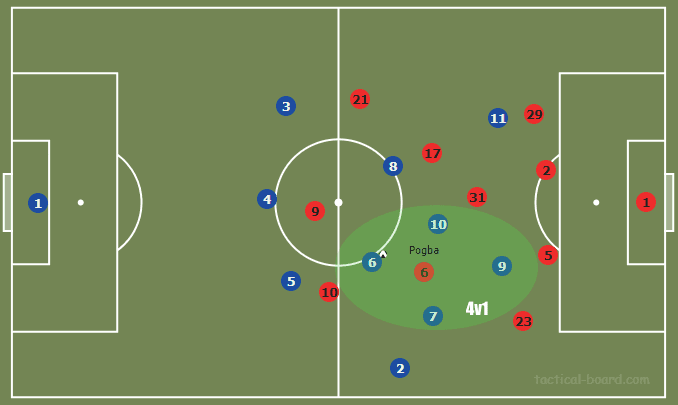
As we can see in the picture, the “incompactness” of Pogba’s side left him with no supportive security, which results in a numerical advantage for opposition. They have double-superiority over the defenders since, besides the surplus, they also utilise on fact that the player who is defending huge area isn’t that good of a defender, so it can get very difficult for the out of possession team.
The compactness erases these advantages attackers have over Pogba since it secures him support and gives him a smaller area to defend.
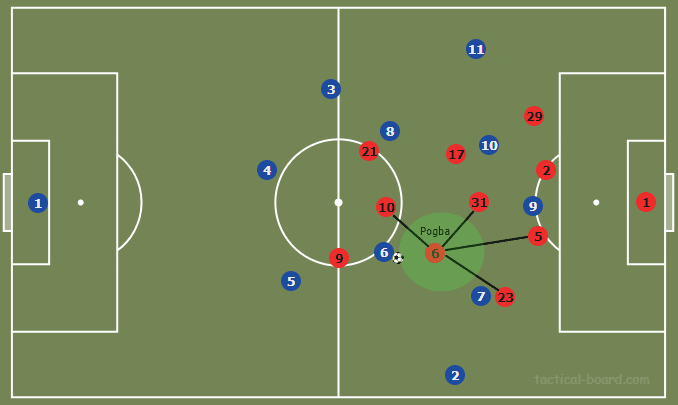
Practically shown, it is clear that compactness can provide teams with an additional tool if they have individuals that are defensively on a lower level. Opposition can’t become as comfortable if the bonds of defenders are solid and if the control of the protected area is fully established. The roles of individuals then “matter less”, since it is more about their good positioning, which can set the image of no-progress for opponents, then about their individual defending that is disguised in the organisation of the structure.
Compactness is based upon horizontal and vertical axes and teams’ tactics vary depending on their abilities and orientation. The best way to benefit out of compact shape is to be fit down both axes and to adjust the orientation to individual characteristics of your players. A team that is probably the prototypical example of well-organised defending structures is Diego Simeone’s Atlético Madrid who base their out of possession game on the opponent’s actions and is perfectly physically prepared for all the tasks they could come out of compactness.
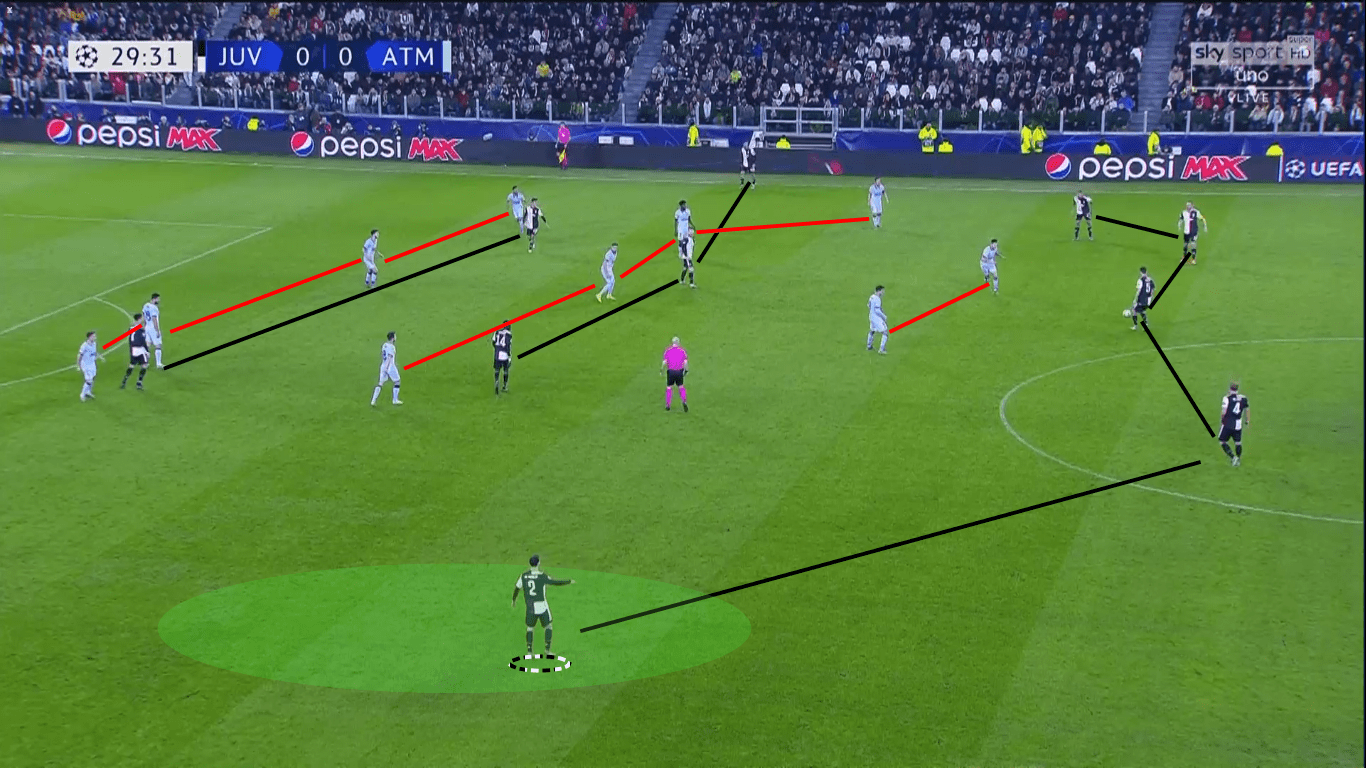
The above clipping is from this season’s Juventus vs Atléti game, and it shows how compact defence can control not only control just the area of the pitch, but also the decision making of the opposition. They’ve closed all the possible options on the ball side with their horizontality and verticality and left them with a “less worthy” solution – pass to the further full-back. The reason because that can be successful for them is the fact the player to whom the ball is addressed doesn’t have a qualitative advantage in 1v1 situations if the situation breaks in that manner, and also they rely on fast transformation.
I wanted to bring to mind this setup of a compact block in order to make incompact ones more clear and easier to understand. Once again, compactness is only theoretically “plain”. In reality, that concept can have its flaws even if the team is well-organised, depending on the opponent, situation on the pitch, individual decisions player make, etc.
Incompactness can be a huge problem for teams no matter upon which axis it is happening – the result can be equally dangerous. The biggest issue it can cause is the gap between the lines, so it isn’t that important if that room is created due to horizontal indiscipline or due to vertical if the output value is the same.
When it comes to vertical dysfunctionality, it is mostly through the transition phases of the game, with a team that needs to set its block misses out on performing the good negative transition. They do it slower than needed and the space between some of the lines gets wider than it should be, ergo optimal for opponents to exploit it.
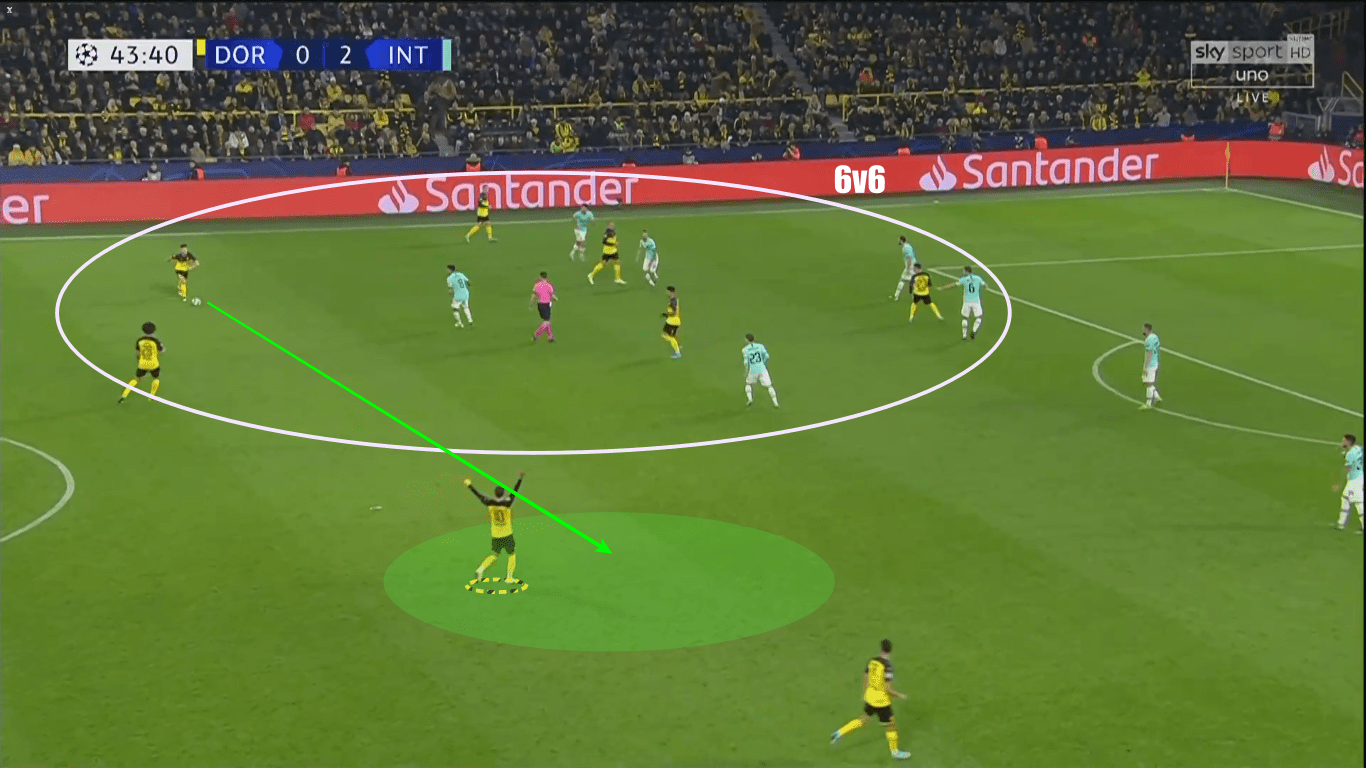
Here we can see an example from Dortmund vs Inter game from this season’s UCL group stage. Even though we can’t see Inter players out of the picture, that is the fact that implicates to their incompactness upon a vertical axis. Roughly speaking, the in possession team has a 4v2 midfield setup if we observe the current position of the ball – counting ball carrier, the player between Inter’s midfielders, and two players in Dortmunds inner and central corridors. If we narrow down the observing angle and move the ball into the green-marked area, Borussia will break into possible 2v1 situation in the right-hand half-space and that is the result of whole defending side’s incompactness.
Although defenders also lack a little bit on horizontality, the main gap was created due to bad backwards runs from the forwards and attacking team can create an in-between overload which can easily cost the defending team. We can also indicate to flaws of ball-orientation, especially when it comes from the incompact team. Six of Inter Milan’s men are on the ball-side, trying to prevent flank play, and that could be of bigger success for them if the general compactness of the team is established, but so it’s not they have a major issue once the ball is played around the ball-concentrated defence.
The lack of compactness upon a horizontal axis can result in pretty much the same outcome. Whilst vertical organisation mostly depends on the speed of actions, transformation abilities of a defensive team and directness of attacking side, a horizontal organisation can be more influenced then opponents if they’ve perfected their positional play. This is not a rule, but it is a common practice in modern football since it evolved from reactive sport into more active one – in possession teams are more and more basing their tactics on their actions, less than trying to react on defensive setups of opposition.
That being said, misplacements in the horizontal organisation of teams throughout games are commonly happening due to oppositions motions/movements of the ball that create dynamic superiority in the exact moment. The phrase “dynamic superiority” demands a whole new piece, but in short, it is the readiness of players to move in whichever way they feel that can result with space and/or time gap-opening for their side. The most popular embodiments of this concept are “dummy runs”, fake motions, rotations or more simple shifting of the defensive team through wide/backwards passes.
All of the mentioned “tools” can easily shift the defence in only one motion, weakening the horizontal connections between the defenders and widening the distance between them, after which they could utilise on the created room. Horizontal incompactness results in the same outcome as does the vertical one – gap is created in the problematic area of the pitch and opponents can penetrate the block easier.
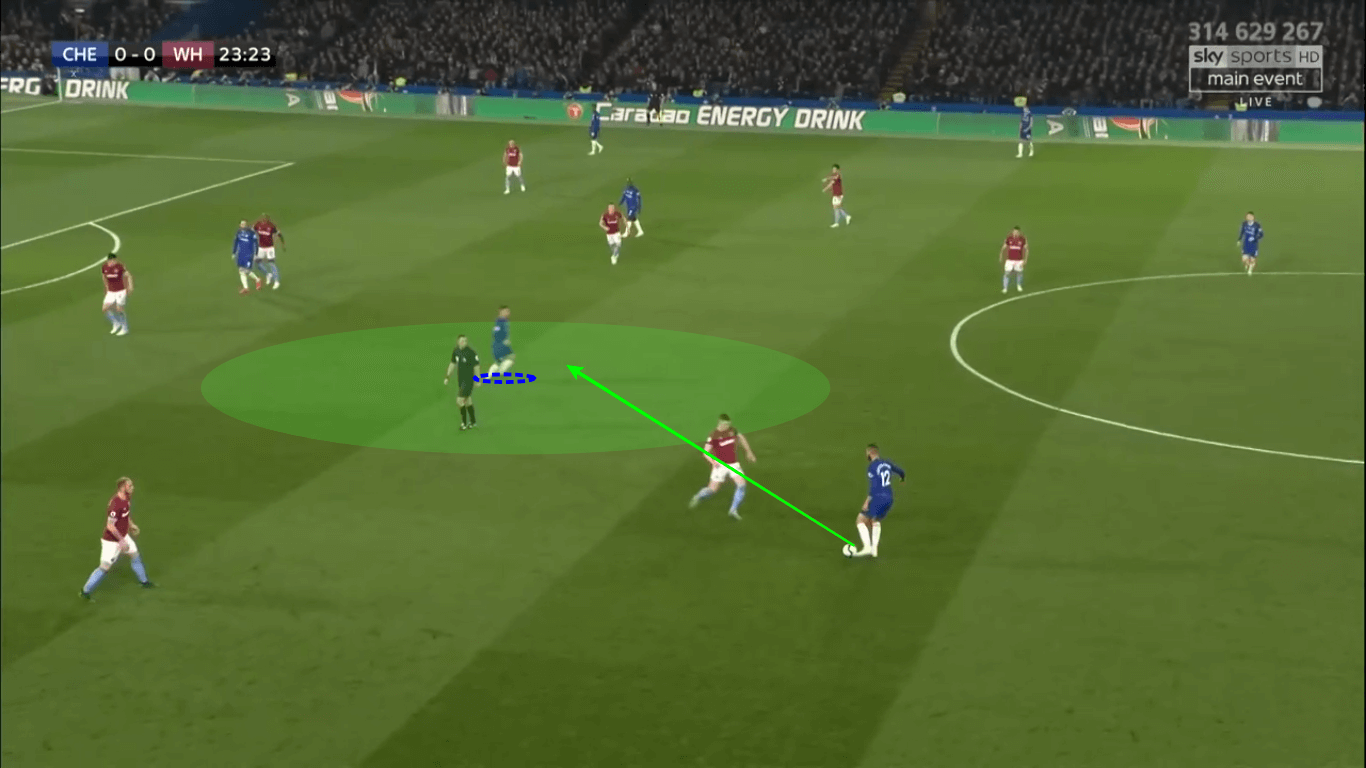
In the picture above we can witness the horizontal incompactness of West Ham side in their duel against Chelsea from the last season. The resulting outcome for them is equally threatening as the one for Inter in the previous example, and it is all due to bad defensive motions of midfielders inside the defensive structure.
Hazard got the ball in a very dangerous area and had enough time to turn towards the goal and penetrate into the box. Not even the supportive angle lacked, but there was one “hurdle” less for the ball carrier, and that was the main issue in the build-up to the goal. Incompactness took away West Ham’s chance to react on the progressive pass from the initial ball carrier to the player who found himself in-between, so the goal they conceded is the direct output of the bad defensive shape.
The point is that incompact defences have less control over the area of the pitch they are defending and because of that less control over the opponents’ future moves. The gaps can be created by being indisciplined upon any of axes, so it is best to be said that vertical compactness loses on its importance if there is no horizontal, and vice versa.
Incompactness can also blossom the existence of defensively “worse” individuals, so in order to camouflage all of team’s or players’ flaws compactness is a great tool for hiding those issues.
Compactness in offence
The whole narrative of the first part of the tactical theory series was about defending and how compactness influences that phase of the game, but it is important to be said that compactness is equally important in the offence. Modern football is all about creating space and exploiting it, so it created a lot of attacking patterns through time which open up the opposition and enable ball possessing team to get the best out of their possession.
Offensive compactness is not that “plain” when talking about the setup of it. It depends on gameplans teams have, their tactics, idea of football and approach along with both their and defending team’s formation. This concept “gave birth” to a lot of different philosophies based upon exact positioning of players inside the variety of zones around the pitch with Juego de Posición (JdP) being probably the most popular one. I won’t get into explaining this type of footballing philosophy since it is great enough to have its own piece, but the idea in the foundation of it is offensive compactness.
The main factors of offensive compactness are the variety of options created due to good team organisation and patterns that secure the progress of the ball in the attacking phase of the game. These patterns are mostly based on the foundation of triangles and rhomboids that create links between the players and are seen as direct passing lanes.
There are no “rights” and “wrongs” in the concept of offensive compactness. It depends on the formation in which team feel most comfortable and through which they could make the ball move most quickly. Juego de Posición divides the field into six zones (lines) horizontally and five zones (corridors) vertically and gives requests that the team needs to fulfil in order to be compact.
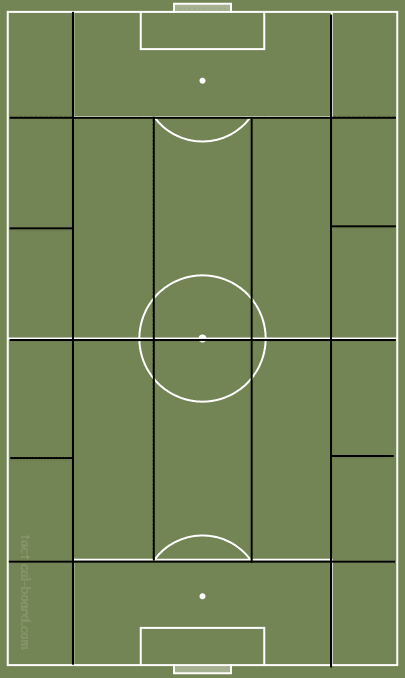
This philosophy defines compactness by having no more than three players in the horizontal line, and no more than two in the vertical one. Different approaches to this concept can lead you to divide “your” pitch in a different manner, but this is the general one Pep Guardiola used through his time in Bayern Munich. Of course, there is a lot more besides the field dividing, but as I said, that’s the topic for a whole other piece.
In a similar way as JdP, offensive compactness set itself on the grounds of not overwhelming areas, and keeping the pitch “as big as possible”. That being said, the attacking teams need to continue engaging basic compactness principles and creating optimal sustainable connections between the players which will help them establish the passing game. Distances between the teammates once again need to be as wide as they could so the passes could go and conquer more zones, or just help the in possession team shift the opponent through distanced balls.
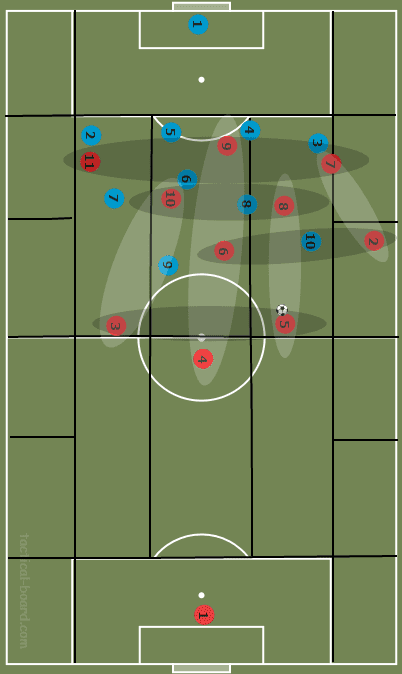
To be more precise, this is not a rule. The key of good offensive compactness is the sustainability of bonds, so if the distances between the teammates are wide but links are weak, the structure can’t be seen as a compact one. It is conceptualised upon the foundation of “option-control” and access-keeping, which are two of the most valuable factors of good offensive compactness. But, what do they mean?
Option-control is an idea of providing as many options as possible to the ball carrier by positioning in the right manner. That means that the player with the ball always has multiple options in reach, since “enough” players are positioned in the zones close to him and are finding the space down the possible passing lanes. This sort of shaping enables ball progress and helps teams flow through the opposing side’s defensive structure.
The access-keeping part of the story is related to the potential ball loss. That means that players from the attacking team are positioned in a way that they can react quickly if the ball is lost – enabling them to counter-press seconds after they lost possession. This factor is about players tracking the action and staying close to the area of happening so they could provide both offensive (progress) support to their teammates, as much as they provide potential defensive support (counter-pressing) if it is needed.
Options and support in the offensive compactness
Offensive compactness is an opponent and situation-dependent idea and the motions of attackers are related to the motions of the ball and defenders. In the picture below, we can see Arsenal’s compact setup from last season’s UEFA Europa League knockout stage game against Rennes where their players are well-positioned and enable the ball carrier to have plenty of options for his next pass. The player with the ball can make a variety of different decision which can lead to him passing the ball to the flank, to the half-space or to the player inside the central corridor, with none of his teammates that can possibly receive the ball being well-guarded.
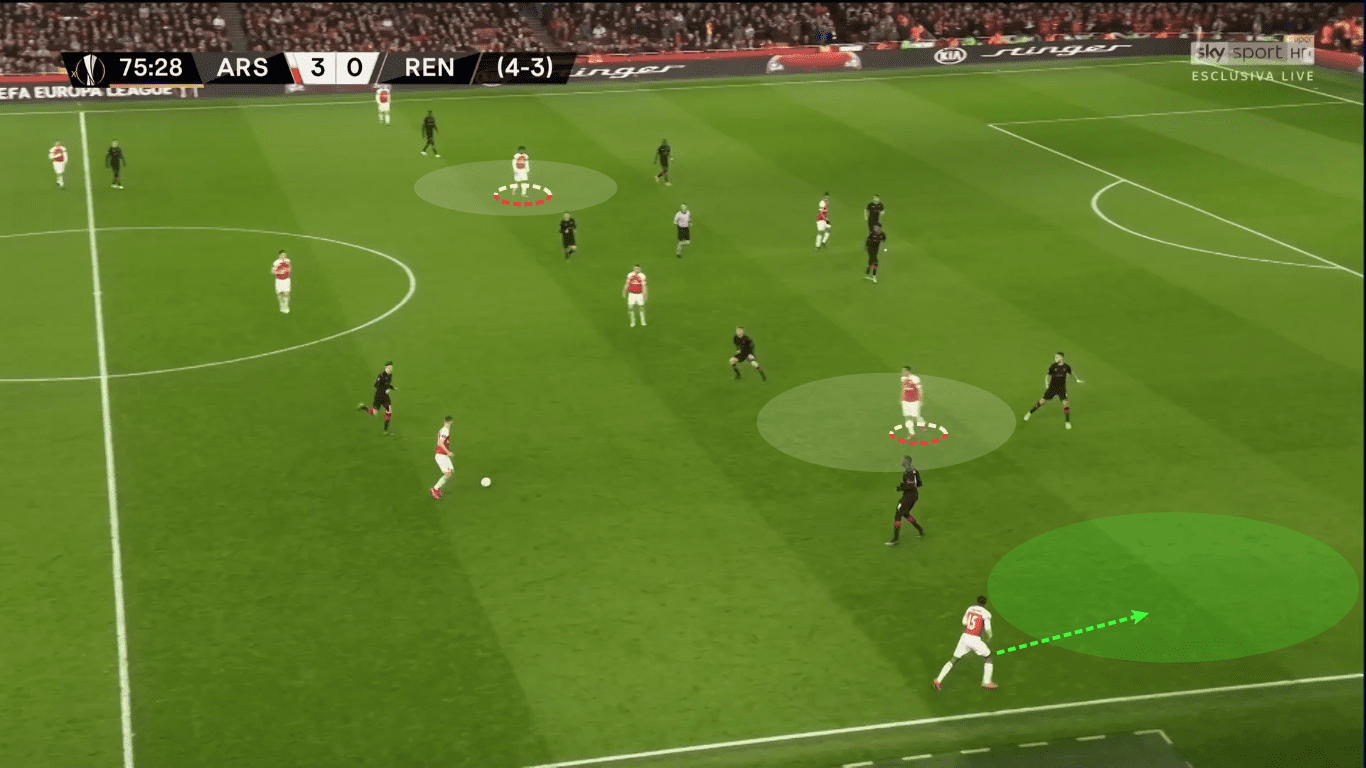
Even though we can’t see the whole setup of the in possession team, it is clear that they have open passing lanes that will help their attack prosper due to their offensive compactness. The entire layout of Arsenal players is sketched in the next image which also points out the fact that offensively compact teams can benefit even more if their opponents are incompact.
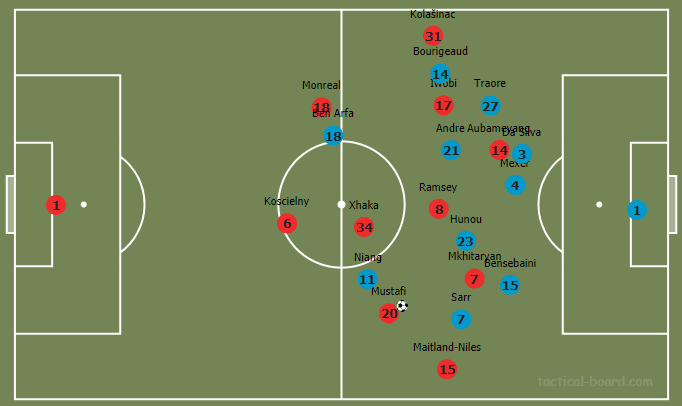
The compact setup is a mixture of active and reactive positions. The attackers have the main task to endanger the opposition’s goal through their compactness and option-providing positioning, whilst they at all times try to stay as close to the action as possible in order to be able to react if the ball is lost.
These setups open up overload creation options for the attacking team if the players are positioned well. The overloads can be created in different zones, and with different players, and they are most commonly created through the constant motions and rotations of the in possession team.
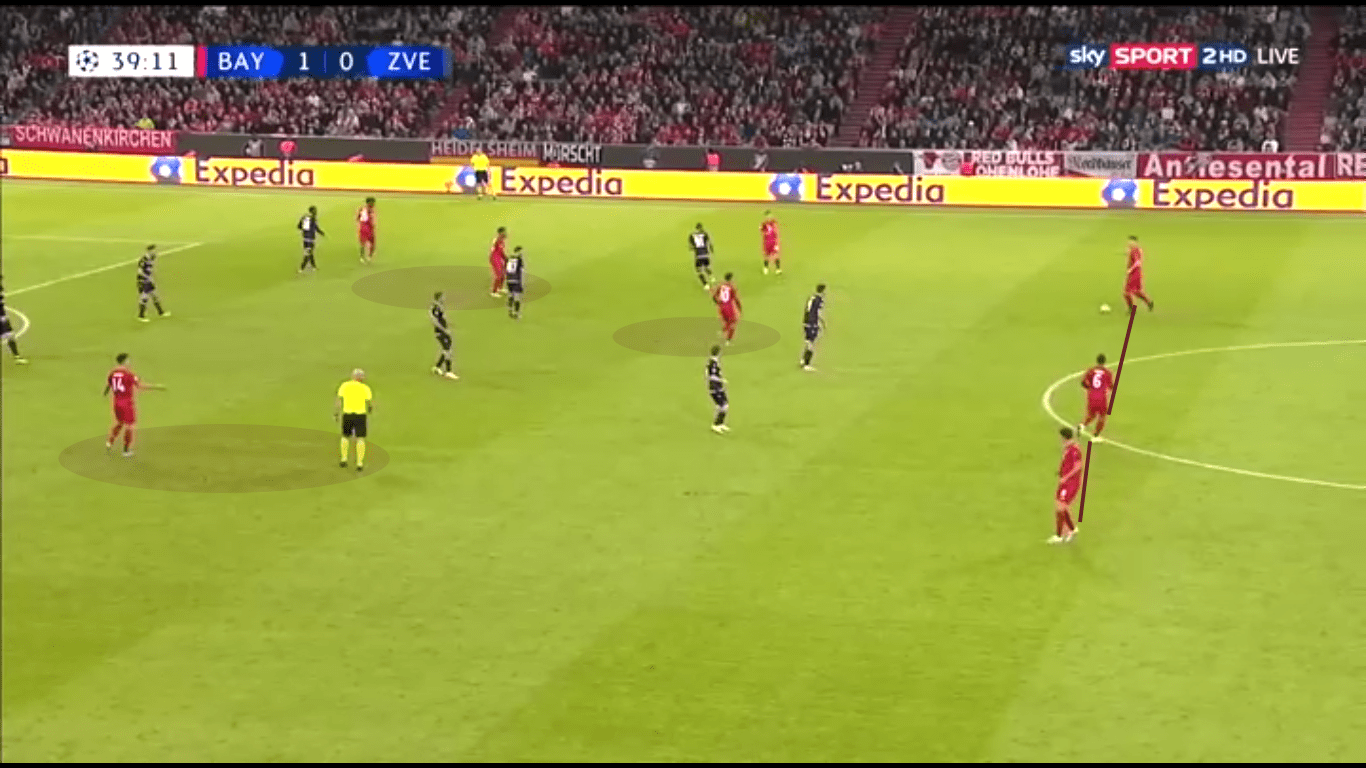
Another example comes from Bayern vs Red Star match, where the possession team kept their compactness even though players rotated and changed positions that they’ve been assigned within the initial formation. The shown setup enables the attacking team to create 3v2 superiority in the midfield even though the opponents are tending to be compact both vertically and horizontally. The issue in defenders’ game is that they are ball-oriented and the small gaps between the lines are exploited by qualitative-superior players so the overload can happen due to both qualitative and quantitative advantage Bayern has.
Their setup is similar to Arsenal’s one from the previous example but is adjusted to the situation on the pitch – opponents’ positioning and flow of the action. The triangles and rectangles in their offensive formation open up a lot of possible passing lanes through the opposition’s block and help them create a numerically superior situation in a variety of pitch-zones. Offensive compact shapes can be both narrow and wide, depending on the playing style of the team. Narrow shapes most usually allow faster reaction if the ball is lost, and the wider ones can make the team more comfortable when in possession since they can help teams stretch opponent easier.
Option-providing is related to the positioning of attackers as much as to the positioning of defenders, so there’s no rule for it and the examples differ according to the exact situation. Teams need to maintain strong bonds in the offence as much as in defence since these can fasten up their attacks and provide them with width or directness – depending on their tactics and initial gameplan.
The ability to react
The second factor of offensive compactness is the access-keeping it provides. By staying close to the action and providing their team with possible progress options, players also enable their side to react quickly if the possession is lost. As I mentioned before, offensive compactness doesn’t have a pattern, it depends on the ball position and coach’s ideas, so different teams can be differently compact.
One of the teams that base a lot of their action on this concept is Red Bull Salzburg, whose attacking compactness directly influences their out of possession game and helps them regain possession quickly. They manage to play counter-pressing/high-pressing game due to their brilliant action tracking in the attacking phase of the game.
They always have an enviable amount of players in reach of the ball carrier, so they provide him with numerous options (also securing possible overloads), mostly in the central zones of the pitch. That helps them be more direct, but also stay closer to the action if something goes wrong.
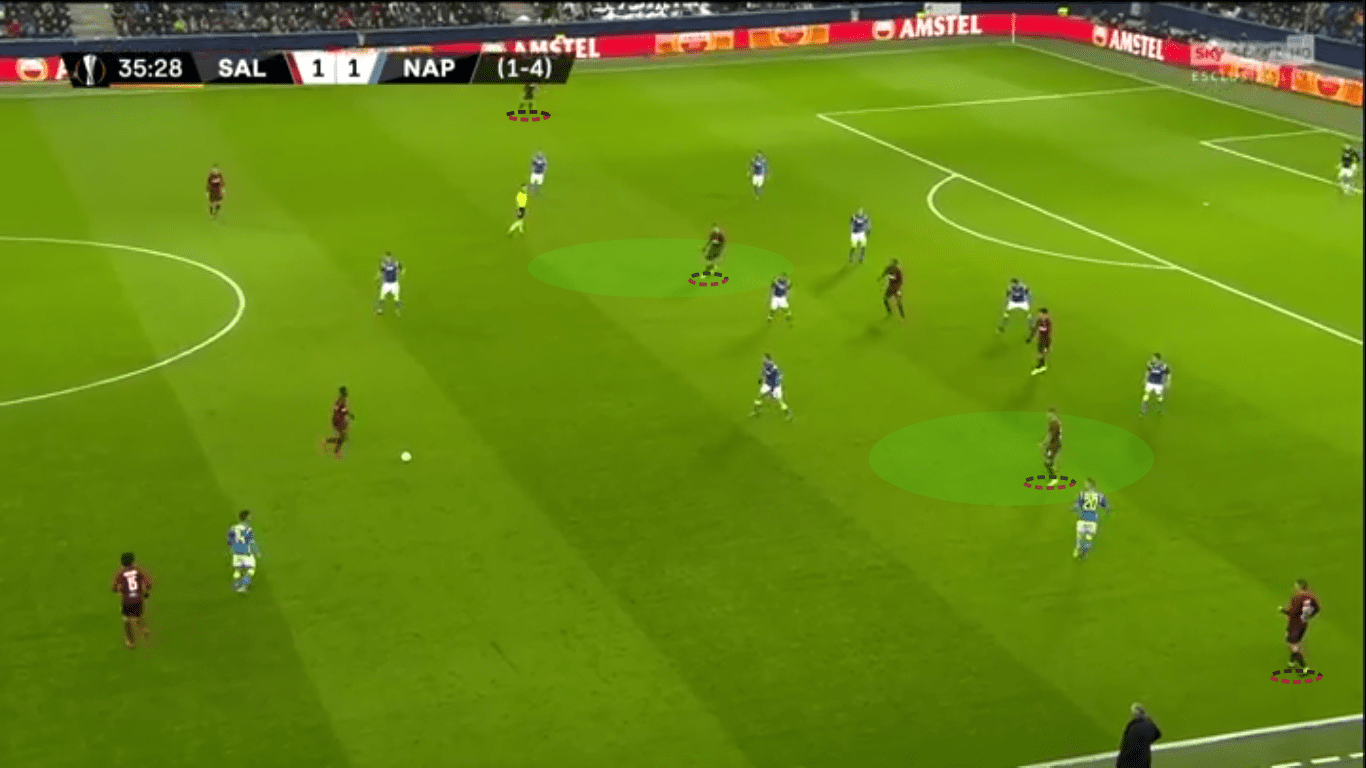
As we can see, Red Bull is compact in terms of potential options player with the ball has and their players are near the action if the ball is passed poorly. Close-positioning opens up possibilities for them, meaning that they can react quickly if the ball is lost since they have a clear high-control over the right half-space because of the initial numerical superiority in the restricted area caused by good positioning.
Similar offensive setups for them led to good pressing and counter-pressing accesses. The idea of having a lot of players close to the action secures that the same amount of initially attack-oriented players can be included in the first phase of defending once the ball is lost. Close bonds of offensive compactness and press/counter-press philosophy are achieved due to the universality of football structures through all of the phases of the game.
The main idea for teams is to have sustainable structures through all of the stages so they could be as prepared as possible for the least expected scenarios in every moment of the game/possession. If the team is offensively compact, the first task for the players is to stay in the optimal distances from each other in order to secure the width and flow of the ball in the best possible way. If their positioning is on the highest of levels, it can have multiple uses, since it can be helpful as the reaction tool. Well-positioned offensive sides often have great access to the opposition in the first seconds when they lose possession because they have a lot of players near the ball who are able and willing to react.
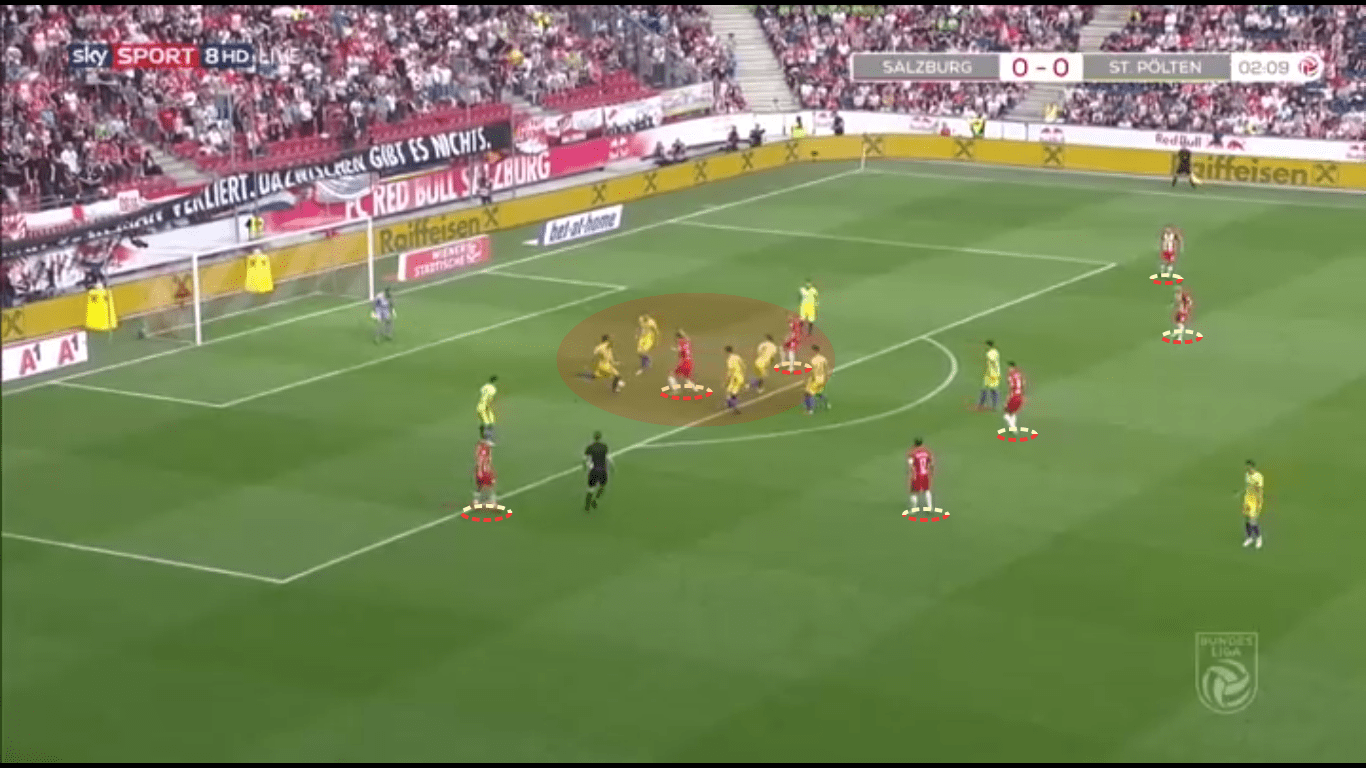
Above we can see how attacking compactness can transform in the defensive pressure. Both concepts are based upon the action-tracking and staying close to the ball so it is clear why good offensive support is mapped to good defensive access.
In the same way, as it is applicable to instant counter-pressing, these setups are also the footing for the more reserved high-press. If the defensive teams are better prepared for transformation and have a better layout of players on the pitch when they win possession, the high-intense counter-pressing might need to be transformed into more cautious high-pressing. Still, the team that lost the ball retains access to the ball and to the opponents but is more calculated in their forward movements.
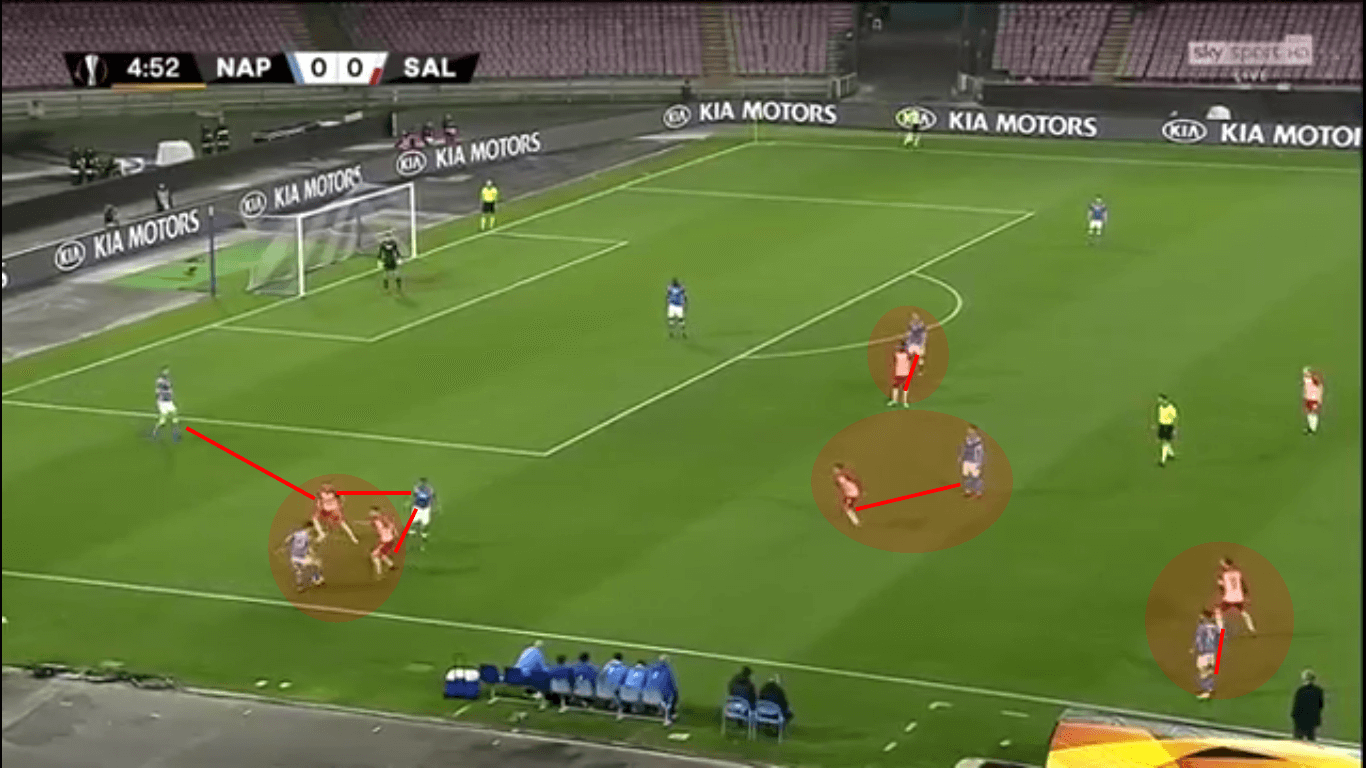
Compactness and transition
In the same way, as it affects the offensive phase of the game, compactness is applicable to the transitive ones. The reason why it is important for the transformation is that the bonds between the players in the defensively compact teams are equally useful once the possession is gained. These connections between the players keep their significance but change their purpose – in defence they are the tool for securing the control over the certain area of the pitch, and when the possession changes feet these links become an option-providing weapon.
In the first seconds of possession switch, players keep their spots but their roles change. Until that moment, their main task was to defend the specified area and now their duty is to be the possible passing option that will enable progress and break opposition’s lines. Optimal distances in the defensive block are now the optimal passing lanes and that’s why these lengths need to be sustainable so they could be of equal value in every phase of the game.
Once the team has won the possession back, “defenders” expectedly become “attackers” and the connections between the players provide teams with only solutions to break through the opposition’s structure. Compactness allows team(s) to transform more quickly and to have plenty of options in reach to the player that initially won the ball.
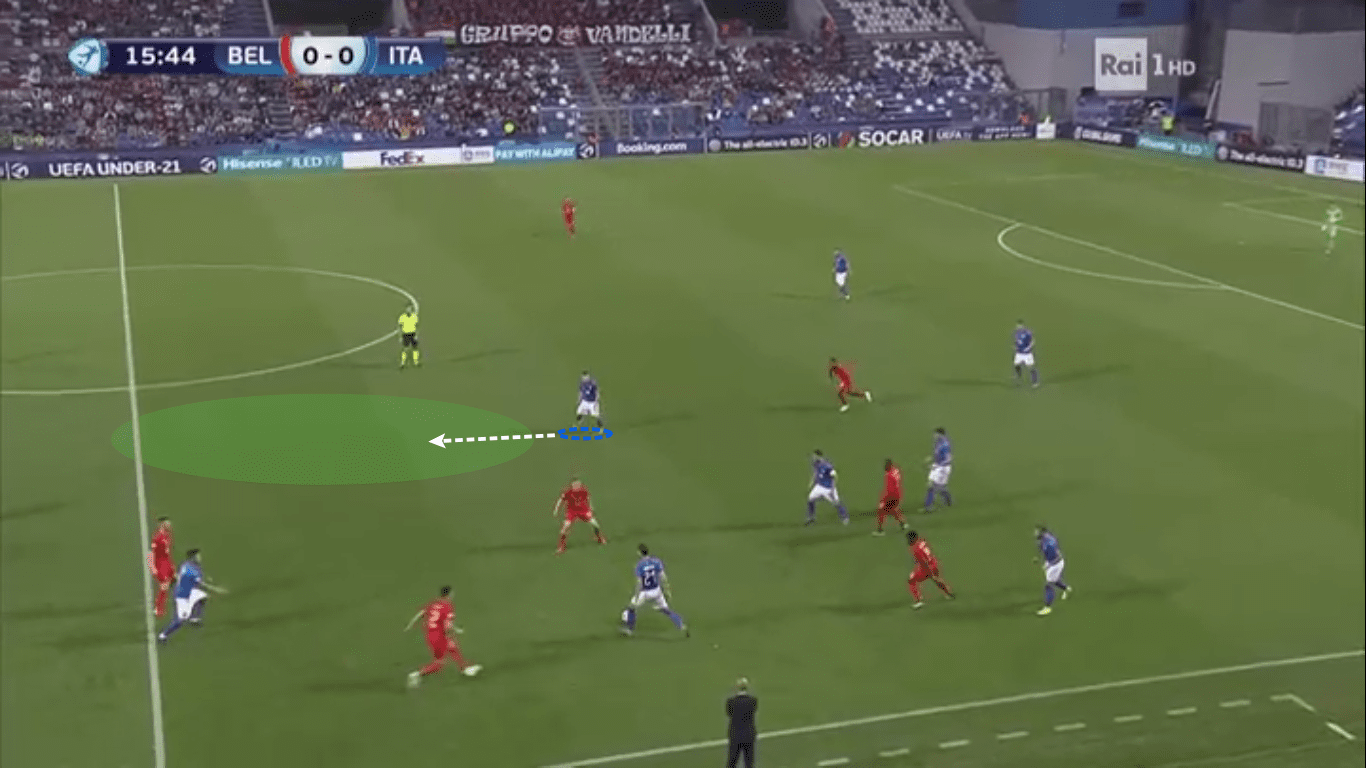
The picture above implicates that compactness is a two-way street. Even though the initial attack from the Belgium side wasn’t good enough, Italy thrived through their counter-press because of their compact defensive setup. The point is that the defensive bonds are not only applicable in the block but also when the ball is won. The stronger links are, the bigger is the possibility for the possession side to progress.
Of course, all of the progressive passes depend on the players’ motions after the ball is won and they can break the powerful links between them with one wrong movement. The transformation from defensive into the offensive compactness relies on the grounds of action-tracking and sense for the game players have so it is important for them to “feel” the motions – open up the passing lanes in the empty spaces by quickly switching their mindset from defence to offence whilst keeping the connections with closest teammates.
The compactness can guarantee fast progress even when the transitions are a bit postponed and teams are more into playing slower positional attacks. The defensive spots from players once again become their progressive positions in the offence, but in these situations, they have more time to find an open room which they could exploit, ergo more time to transform from one compactness to the other.
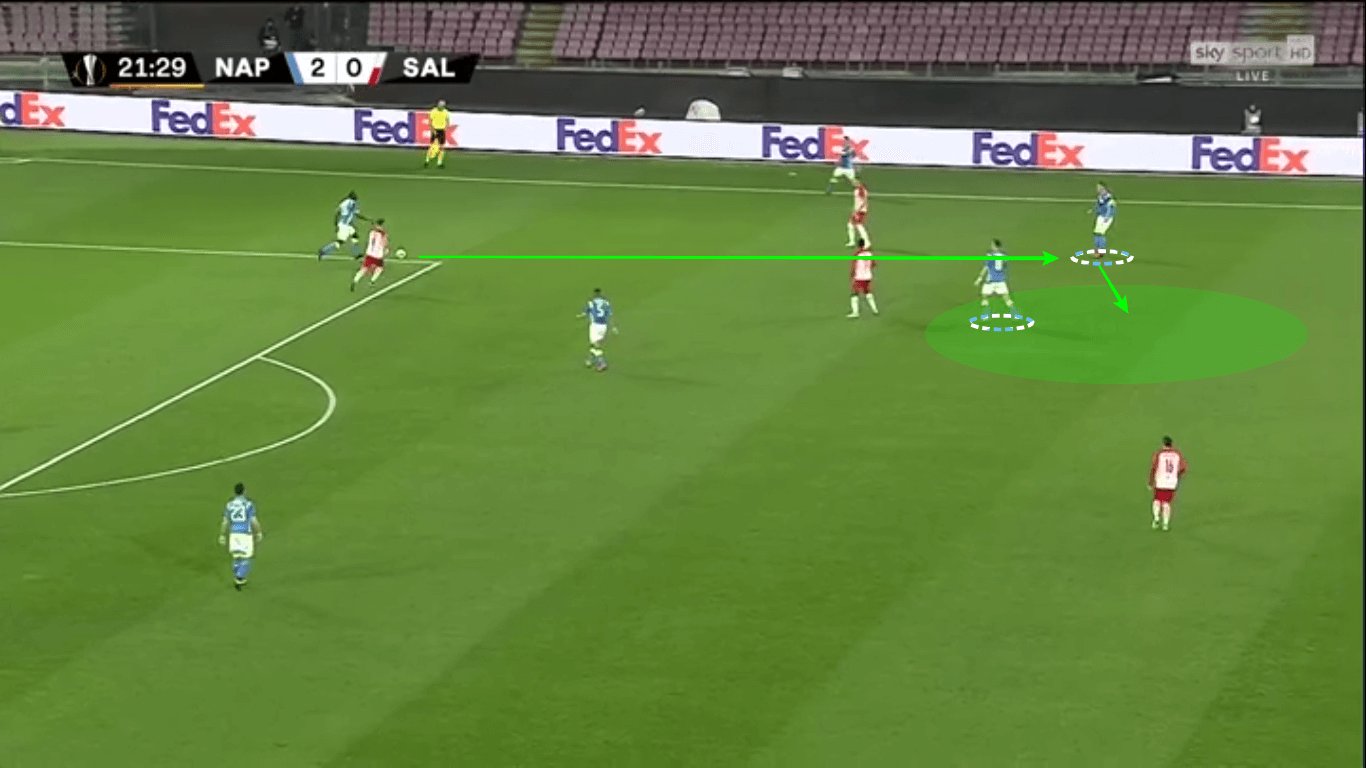
Conclusion
In this two-piece series about compactness, I tried to explain the main principles of compact structures in all of the game phases. The concept lays upon two grounds all the time – 1. the control of the situation offensively and defensively and 2. the possibility of access to the ball, both from option/supportive angle and from a defensive perspective. This tactical theory analysis was focused on the blanks that were left open after the vol. 1, and it highlights the importance of connections between the players throughout a variety of situations in the game.
There sure is plenty to be written about compactness, but that will need to wait for some other piece (which will surely be written!). The idea of compactness is much more complex than it looks like at first glance.
It influences the game from plenty of different angles and can be used as one team’s strongest weapon, while at the same time as their weakest spot, according to the scene happening in the field and approach players have as individuals and as a unit. That being said, it is clear that this concept is one of the most important in today’s football and it sure needs to be observed with a more in-deep approach.





Comments